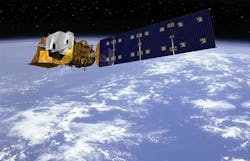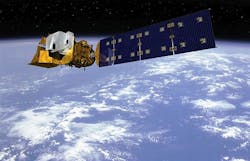Orbital ATK to build NASA Landsat 9 land remote sensing satellite
DULLES, Va., 27 Oct. 2016. National Aeronautics and Space Administration (NASA) officials needed an aerospace partner to design and build Landsat 9, an advanced land surface mapping satellite to be operated by the U.S. Geological Survey (USGS). They found their partner in Orbital ATK Inc. (NYSE:OA), a global provider of aerospace and defense technologies in Dulles, Virginia.
Under the contract, Orbital ATK will design and manufacture the satellite, integrate the two government furnished instruments with the spacecraft, and support launch, early orbit operations, and on-orbit check-out of the observatory. Landsat 9 is scheduled for launch in December of 2020.
Artist's concept of the Landsat 9 satellite (Credit: Orbital ATK)
Landsat 9 is based on the company’s LEOStar-3 platform, the medium-class low-Earth-orbit spacecraft flown on Landsat 8 and NASA’s Fermi and Swift Gamma-ray astrophysics observatories. This platform is also under contract for the upcoming ICESat-2 Earth science satellite and the Joint Polar Satellite System (JPSS)-2 spacecraft. Landsat 9 will be designed, manufactured, and tested by Orbital ATK’s Space Systems Group at its facilities in Gilbert, Arizona, the same location and production team that executed the Landsat 8 program.
The Landsat 9 satellite extends the Landsat program's record of global terrestrial imagery to half a century. Orbital ATK has a history of supporting Landsat satellites, including the success of the company-designed and built Landsat 8 satellite, which was launched in 2013 and is delivering high-quality images in quantities exceeding mission requirements. The company was also responsible for the Landsat 4 and Landsat 5 satellites launched in 1982 and 1984.
“Landsat represents over four decades of imagery, providing valuable data for agriculture, global change research, emergency response, and disaster relief. We’re proud to build upon the success of our previous Landsat projects with the delivery of this new satellite,” says Steve Krein, vice president of science and environmental programs at Orbital ATK.
Orbital ATK designs, builds, and delivers space, defense, and aviation systems for customers around the world, both as a prime contractor and merchant supplier. Its main products include launch vehicles and related propulsion systems; missile products, subsystems and defense electronics; precision weapons, armament systems and ammunition; satellites and associated space components and services; and advanced aerospace structures. Headquartered in Dulles, Virginia, Orbital ATK employs approximately 12,000 people in 18 states across the U.S. and in several international locations.
Search the Aerospace & Defense Buyer's Guide
You might also like:
Subscribe today to receive all the latest aerospace technology and engineering news, delivered directly to your e-mail inbox twice a week (Tuesdays and Thursdays). Sign upfor your free subscription to the Intelligent Inbox e-newsletter at http://www.intelligent-aerospace.com/subscribe.html.
Connect with Intelligent Aerospace on social media: Twitter (@IntelligentAero), LinkedIn,Google+, and Instagram.
Intelligent Aerospace
Global Aerospace Technology NetworkIntelligent Aerospace, the global aerospace technology network, reports on the latest tools, technologies, and trends of vital importance to aerospace professionals involved in air traffic control, airport operations, satellites and space, and commercial and military avionics on fixed-wing, rotor-wing, and unmanned aircraft throughout the world.


